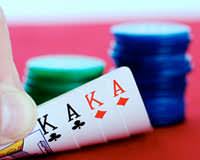Plo Hand Rankings
Starting Hands in Pot Limit Omaha (PLO) In Omaha, we naturally have more chances to make a hand on the flop than in Texas Hold’em. Our four hole cards give us many more potential hands, and so there are many more types of possible starting hands in Omaha. The strength of our hand. Omaha Hi-Lo Preflop Hand Values. There are 16,432 different starting hands in Omaha Hi-Lo Holdem (considering equivalence relations). The table on this page shows the top 5% of hands dealt, click here to see all of the hands, the page is almost 2MB so may take a while to load. The table is generated using a java program which randomly deals 10 players and 5 community cards, finds the winner/s. In pot-limit Omaha, the poker hand rankings are just the same as in Texas hold'em. Like hold'em, pot-limit Omaha or 'PLO' poker is played as a 'high-hand' game, which means the hands go (from best.
It can be tempting to play a lot of hands in Omaha Hi-Lo 8 or better games – after all, high-only hands will win the pot some 30% of the time! This can be even more temping when you can see a flop relatively cheaply after a number of limpers… now the cold, hard facts – the quickest way to lose your bankroll is to play too loose in Omaha/8 poker. In fact you should be playing less starting hands than in other forms of poker, after all hands which can hit both the high and the low side of the pot with the nuts do not come along too often.
This guide will look at the various starting hands for Omaha Hi-Lo poker including PLO8. We start with the strongest hands of all and then drill down to speculative holdings. Your objective with every hand you play in Omaha Hi-Lo are twofold, to ‘scoop’ both the high and the low sides of the pot and to avoid being quartered – these objectives must be considered every time you enter a pot if you are to be a long-term profitable player.


Best Plo Hands
Premium Hands

The very best PLO8 and O8 starting hands are known as ‘suited babies’, that is to say small suited cards with an ace suited with at least one other card. These hands have the very best chance of scooping both sides of the pot. They can make ‘nut low’ hands with the small cards, and the ace + flush potential gives a great opportunity to win the high side of the pot also. A double suited (2 cards of each suit) hand will add to this strength still further. A pair of aces double suited with 2 babies is a potential monster in Omaha 8 or better – the potential to scoop here is huge.
Very Strong Hands
In this category come hands with both low and high potential that can not quite be considered premiums. Small cards are still favored, especially with an ace included as this gives high possibilities. Ace hands which contain 4 ‘babies’ are considered strong as they have both low and low straight potential. Hands with and ace-2 and another small card can be played where they have ‘backup’ for the high, for example a king suited with one of the small cards. K-K-A-X where X is a card 4 or below can also be played strongly in many circumstances.
High-Only Hands
Since the flop will not make a low hand possible 30% of the time there is a place for high only hands. However, these need to be played only when it is cheap to see a flop and where you are prepared to fold quickly should you not hit a nut hand (or very strong high draw with no low possible). High only hands should be the strongest possible, A-A-K-K or A-A-J-10 double suited being the very best – play these from late position and with caution!
Non-Ace Hands
While playing only hands with aces will keep beginning players out of trouble there are playable hands which do not contain these. The best would be 2-3-4-5 or 2-3-4-6 which give you a combination of low and straight possibilities, if betting gets heavy and there is no ace on the board then you may be beaten for the low when holding non-ace hands.
Marginal Hands
The worst hand to make in any form of poker is the 2nd best hand, especially in a game such as PLO8 where finding out you are behind can be very expensive indeed. Hands with A-2 and 2 medium cards can be considered marginal, you are unlikely to make a high and are in danger of being quartered when you make the nut low. Cards with some backup in the form of an additional low card A-2-4-9 for example are a little stronger a suited ace and weak opposition could push these hands into the ‘playable with caution’ category from later position. See our article on Ace-2 errors for more on this important subject.
Omaha Hand Rankings
Of course, not all opponents are equal when it comes to Omaha Hi-Lo on the internet. To find the fishiest tables today why not check out our detailed look at the Best Sites For Omaha Hi-Lo and find a site with serious profit potential today!
The Basic Rules of Pot Limit Omaha (PLO)
Best Pot Limit Omaha Hands
Omaha is a poker variant in which each player is dealt four “hole” cards (cards that the other players can’t see) and then share a five card board. It is similar to Hold’em in its play, with flop, turn, and river cards dealt in succession on the board, interspersed with betting rounds. The most common betting structure for Omaha is Pot Limit, in which players can only bet the size of the pot, including their call.
The play begins with each player being dealt four cards. Unlike Hold’em, players must play exactly two cards from their hand and exactly three from the board. Hand rankings are the same in Omaha and Hold’em, with a high card being the worst and a royal flush the best possible hand.
In PLO, the play starts with a small and big blind, which rotates each turn. The first player after the big blind (Under the Gun – UTG) may fold, call the big blind, or raise up to the “pot limit.” If the blinds are $1 and $2, the UTG player can bet up to $7. Things then get a little tricky. The second player can now fold, call the $7 or bet up to $24. This betting structure takes a while to get used to. See our How to Calculate Pot Limit article for more examples. When in doubt, if you would like to bet the maximum, you can always announce that you bet “pot” and the dealer will figure out the amount for you.
Plo Hi Lo Hand Rankings
Note that starting hand values are quite different than in Hold’em, so you’ll want to familiarize yourself with these differences before playing Omaha. The “Advice” button in our PLO simulator can help you with this.
Good Starting Hands In Omaha
Hand equities run much closer together in Omaha, and thus more players will generally stay to see the flop than in Hold’em. With the ability to select the best two of a four card hand, winning hands in Omaha also tend to be quite strong. Single pairs and two pairs are rarely likely to take down the pot, and players should be drawing to nut straights and flushes if they decide to draw.
As you might imagine, Omaha pots can grow quite big, and with pre-flop hand equity advantages rarely larger than 60% variance swings in PLO can be big as well. The PLO player will need a larger bankroll than the typical No-Limit Hold’em player for that reason.